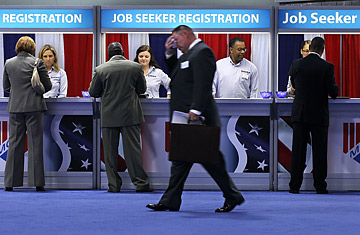
A job seeker passes by the registration booths during a career fair at the Walter E. Washington Convention Center September 27, 2011 in Washington, DC.
America was once the great middle-class society. Now we are divided between rich and poor, with the greatest degree of inequality among high-income democracies. The top 1% of households take almost a quarter of all household income--a share not seen since 1929. An economy this lopsided cannot prosper. The poor and working classes are squeezed. The rich are increasingly absenting themselves from the country's troubles. Their businesses sell goods and outsource jobs to China; their homes are behind gated walls; much of their corporate income is in offshore tax havens.
It should be no surprise that our politics are foul as a result of it all. The rich finance candidates while the poor cannot. Political scientists have shown that members of Congress--many of whom are wealthy themselves--devote their legislative votes to the wishes of their well-to-do constituents. President Obama has dined regularly with the lords of finance; meanwhile, billionaire oil magnates fund the tax-cutting frenzy of the Tea Party.
America has been here once before. In the first three decades of the 20th century, new fortunes in industry pushed up incomes and wealth at the top while mass immigration set a low floor. The Republicans won the White House throughout the 1920s--Harding, Coolidge and Hoover--and the Supreme Court weighed in for the big corporations, striking down labor standards, minimum wages and other social protections.
Then came the Great Depression in 1929 and Franklin D. Roosevelt's New Deal four years later. FDR railed against "a small group [who] had concentrated into their own hands an almost complete control over other people's property, other people's money, other people's labor--other people's lives."
Today the economic and political forces are different, but the need for a new course is the same. On the economic front, the rise of China and globalization are the critical new variables. Great profits are being earned, and kept, abroad. At home, workers with lower skills and education are being squeezed by competition from overseas. Manufacturing has shrunk.
How did we get here? Certainly prosperity hasn't always come at the price of large-scale inequality; quite the contrary. The 1950s and '60s marked an era of rapid economic growth and narrow differences in income. This was partly the result of a more robust social safety net. The New Deal, World War II and the vigorous postwar recovery had reversed the outlandish inequalities of the 1920s. Top tax rates were 70% or higher till the Reagan years, and the economy grew robustly nonetheless. Social Security, the GI Bill, interstate-highway construction and many other programs ensured that the elderly were protected, higher education was increasingly within reach of all, and the business sector had the modern infrastructure needed to prosper. In this highly effective "mixed economy," one bolstered both by business and by activist government, the gap between rich and poor narrowed substantially.
Things began to fray, and fray badly, in the 1970s. The U.S. dollar was toppled from its unique perch; oil and food prices spiked; Japanese automobile imports began to challenge the Big Three automakers; and inflation soared. America was experiencing its first taste of the new globalized competition.
